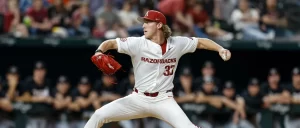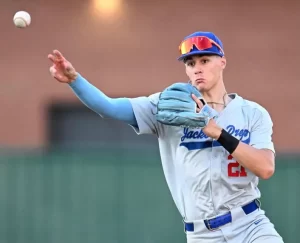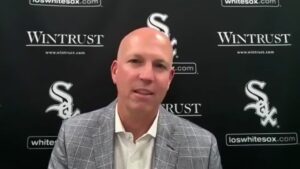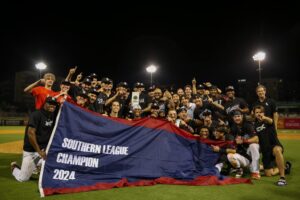Canceling 2020 MLB Draft Would Be A Costly, Short-Sighted Blunder
According to the frightening report from the Associated Press, Major League Baseball is considering canceling the amateur draft this year. There is also some thought being given to the idea of wiping out the coming international period as well. The reasoning for this idea would be to “preserve cash” while games are affected by the recent concerns brought forth by the coronavirus pandemic that is currently engulfing the planet.
For the first time ever the draft was scheduled to take place on June 12 live from the College World Series in Omaha, Neb.
In a recent column by The Athletic’s Ken Rosenthal, the veteran scribe posited that the league would like the event to take place as scheduled currently. We aren’t living in a normal world right now under circumstances that are typical at the moment, however. Rosenthal also surmised that one possible solution that has been discussed would involve combining the 2020 and 2021 draft at a later date. While seemingly an option, it’s one that would be highly problematic for college juniors and high school seniors.
Service time is the most contentious issue being discussed by the league and its players currently, but the draft is seen as one way to curtail lost revenue. Expected cash won’t be coming in from tickets, broadcast and sponsorship contracts. Teams are fearful that they may have to lay off administrative staff members while this delay continues. Signing bonuses from the draft and international market total around $400 million annually.
One league source has indicated to FutureSox that Major League Baseball and the Players Association are currently discussing the expansion of teams access to credit currently. Clubs will still be on the hook for millions of dollars in player salary in addition to operating costs while there are no fans in seats with early contest cancellations the current expectation. The deductibles on loss of business insurance on player contracts is very high and teams will be shelling out money even without the games being played.
When teams hemorrhage cash, cuts are inevitable. The draft is seen as a logical cut for some but it’s a foolhardy proposition. Despite being the lifeblood of an organization, many owners still despise spending on the amateur draft in general. The idea is one that would be extremely short-sighted but one that hasn’t been a surprise to multiple league scouts. Multiple scouting sources told FutureSox that some clubs would likely be on board with the decision.
Certain clubs that didn’t work hard enough in the summer and value live looks at players from top executives might not mind this decision if it ultimately came to this. They’d regret this thought process in subsequent years though. Other scouts have told us that they expect a draft to occur but predicted that it would be on a much smaller scale. Currently, the Rule 4 Draft consists of 40 rounds. Another option appears to be moving the draft back and lowering the number of rounds to 20-25, which also poses some considerable issues for minor league staffing and the 2021 scouting process.
Uncertainty is paramount at this juncture but skipping the amateur draft would be foolish. Teams traditionally spend between $10-$15 million on the draft. Baseball owners didn’t become billionaires by giving away their money but surplus value is a considerable factor that these businessmen seemingly should have a grasp on. Getting rid of an event that costs owners the equivalent of one year of a solid back end starter to reap the rewards of over $100 million in assets and selling it as a cost-cutting mechanism would be a mindless false equivalency.
Young talent is a real asset in the sport of baseball. Every organization is looking for cost certainty and places a premium on cost-controlled assets. Astute executives are remiss to trade premium prospects and the value of said assets is guarded more appropriately than ever. If MLB decides to cancel their draft, commissioner Rob Manfred would take a hearty leap over the National Hockey League’s Gary Bettman as the worst in the four major sports.
What Seems Likely?
The most likely outcome seems to be that there will in fact be a draft at some point but when that actually occurs is anyone’s guess at this juncture. The NCAA has canceled the rest of their spring season including the postseason and the majority of high schools across the country are on the precipice of losing their seasons as well. Scouts aren’t scouting currently with all major league staffs grounded at the moment but there really isn’t much to see anyway.
Keith Law of The Athletic wrote an outstanding piece this week pertaining to how the pre-draft process could unfold with quotes from prominent executives. Some executives would prefer to move the draft date up. The thought would be to get players into organizations whether it be with extended spring training or short season clubs. Others suggested that the date should be moved back further into June or even July.
In this case, regional combines could be setup so that clubs could get an additional look at draft eligible prospects. Sources have told FutureSox that the majority of expected high picks would likely decline invites to an event such as this however. With zero incentive to participate in a combine style workout, top players would likely rely on their history and past exploits.
Detroit Tigers general manager Al Avila told Law that his organization would be in a position to draft today if necessary, but recognized that having the first pick in each round does have its advantages. Multiple area scouts have indicated to FutureSox that they’d feel comfortable going off of reports currently filed as well. Data isn’t as useful with a small sample but all 30 clubs should theoretically have the same information.
The league is holding out hope that the 2020 draft will take place on June 12 in some form. This would allow players to enter an organization in a typical fashion and allow scouts to ramp up scouting efforts for the 2021 draft in an appropriate manner. The likelihood of the draft date moving in some fashion is pretty high, but punting on this form of talent procurement seems like a dastardly devastating idea that would cause more harm than good for all involved.
Jim Callis of MLB Pipeline talked to us about his take on our podcast. Callis said, “If they had to draft tomorrow — would you wish you had more looks? Yes. But everybody has gotten looks at guys last summer, they build up scouting databases on players … I don’t think that even though this is the most unique circumstances the draft has ever faced with the coronavirus, that teams are really going to do much differently. For most teams, this is business as usual.”
Best Interests of the White Sox
Bonus pools haven’t been released to date, but the White Sox would likely have an allocation in the $8.5 million range. The organization has done a stellar job of spending all of their available resources on the amateur draft in recent years and the expectation is that this year would be no different. The change in philosophy has been a welcomed trend for the franchise overall.
Before the most recent collective bargaining agreement was put into place, White Sox chairman Jerry Reinsdorf rarely showed a willingness to spend the proper amount on amateur talent. When the top clubs in the sport were exploiting the rules to add premium young talent, Reinsdorf strictly adhered to perfunctory salary thresholds put in place to suppress salaries for amateur players.
The organization has undergone a significant shift in this regard, but sins of the past leave a poor taste when wondering which side of the lectern the organization would be on in regards to this cost-cutting maneuver currently being considered. The White Sox have a large scouting department and they’ve had boots on the ground covering the college and prep class for 2020 in advance of the June festivities.
Mike Shirley is the man in charge of this scouting process and he’s indicated that his staff would be more focused on prep talent than his predecessors. The scouting staff could be at an advantage if the draft remains in early June and they could benefit from their extensive history of live looks if they’ve in fact seen these players for the final time.
Under the leadership of former amateur scouting director Nick Hostetler, area scouts were trusted with reports and given the ability to strongly recommend players that hadn’t been seen live by top decision makers. The Bryce Bushes and DJ Gladneys of the world could struggle to be seen in a situation like this and the organization’s willingness to trust its employees could pay significant dividends.
Extensive change isn’t expected under Shirley and the situation should be seen as business as usual for the White Sox. The organization has understood the importance of the draft in recent years and will likely be prepared to deal with whatever unknown factors come their way in the lead up to eventually adding more talent to the organization later this year. The clouded history of ownership in regards to amateur spending will likely offer pause to some observers during these trying times.
Want to know right away when we publish a new article? Type your email address in the box on the right-side bar (or at the bottom, if on a mobile device) and click the “Subscribe” button. Our list is completely spam free, and you can opt out at any time. Also, consider supporting FutureSox on Patreon! You can get early access to special articles and Patreon-only posts, in addition to more benefits you can read about here. Shop our exclusive merchandise! Show your support with the latest FutureSox apparel.






